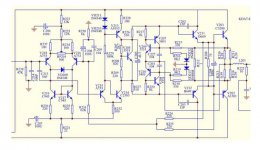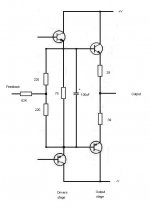Hi Bob,
It would be relatively easy to hardwire the output stage and provide a robust connector setup to plug in various input stages. For basically $50 for a set of pcbs, different stages could be built, listened to and tested... In stereo, on a common platform.
What would a basic buildable design consist of? I personally like the concept of no frills and starting from only the essentuals; adding complexity later if the first step works out.
Regards, Mike.
It would be relatively easy to hardwire the output stage and provide a robust connector setup to plug in various input stages. For basically $50 for a set of pcbs, different stages could be built, listened to and tested... In stereo, on a common platform.
What would a basic buildable design consist of? I personally like the concept of no frills and starting from only the essentuals; adding complexity later if the first step works out.
Regards, Mike.
MikeBettinger said:Hi Bob,
It would be relatively easy to hardwire the output stage and provide a robust connector setup to plug in various input stages. For basically $50 for a set of pcbs, different stages could be built, listened to and tested... In stereo, on a common platform.
Regards, Mike.
Actually, now that the day is done and I can think a bit clearer, two boards: output stage, input. The rest is obvious, other than the choice of test designs.
Mike.
MikeBettinger said:Hi Bob,
It would be relatively easy to hardwire the output stage and provide a robust connector setup to plug in various input stages. For basically $50 for a set of pcbs, different stages could be built, listened to and tested... In stereo, on a common platform.
What would a basic buildable design consist of? I personally like the concept of no frills and starting from only the essentuals; adding complexity later if the first step works out.
Regards, Mike.
Hi Mike,
Yes, such an approach could be the basis for an interesting set of experiments, both from the point of view of tesing and listening. I agree that a good, but simple, no-frills design would be a good foundation. If it typified many industry design approaches, it might lessen the amount of "oh, but that's a special case" stuff. That's one reason I chose the topology I did for the simulation comparisons - I see it as being not fancy, but pretty representative of what's out there.
Such an experiment, housed in a reasonable prototype enclosure, could actually serve the needs of some "semi-blind" tests if a person other than the listener switched in different cards. This is not perfect, of course, but it is better than the listener himself taking apart the amplifier, soldering in a different capacitor, and then sitting back down to give a listen for differences.
Cheers,
Bob
It depends on the bias of the output stage (since it is a single pair). High bias, its OK.
If you got good output stage, you can even take the feedback point from VAS (look at NP's Statis amps, it is done by many transistors+sufficient biased output stage)
If it is low biased (classB/AB), the differential cannot "sniff+fix" Xover distortion+loudspeaker impedance nonlinearity (because feedback is taken from driver's emitor, and there's C204 stabilizing voltages there), but at the other side, this Xover distortion won't enter the feedback system. Output impedance will rise high.
If you got good output stage, you can even take the feedback point from VAS (look at NP's Statis amps, it is done by many transistors+sufficient biased output stage)
If it is low biased (classB/AB), the differential cannot "sniff+fix" Xover distortion+loudspeaker impedance nonlinearity (because feedback is taken from driver's emitor, and there's C204 stabilizing voltages there), but at the other side, this Xover distortion won't enter the feedback system. Output impedance will rise high.
Hi Lumanauw.
Thanks for you reply.
One question
Pros and cons of the feedback from VAS (Stassis), Drivers (Koda) and output?
GEirin.
Thanks for you reply.
One question
Pros and cons of the feedback from VAS (Stassis), Drivers (Koda) and output?
GEirin.
Hi, GEirin,
You forgot another type, feedback from dummy output stage (SPLIFF).
The farther feedback is taken from output node (which connects to loudspeakers), the less control you get over that node.
You forgot another type, feedback from dummy output stage (SPLIFF).
The farther feedback is taken from output node (which connects to loudspeakers), the less control you get over that node.
I cannot for the life of me understand why you would want to take feedback from the driver stage (probably running class A, so distortion inhererently low) and leavve a class B stage open loop . . . .
Is the question not one about having high overall loop gain or low loop gain?
Local feedback to correct non-linerarities vs overall GNF to correct non-linearities?
etc
Is the question not one about having high overall loop gain or low loop gain?
Local feedback to correct non-linerarities vs overall GNF to correct non-linearities?
etc
Hi.
I´m interested in know why KODA KD261 use this topology. To know advantage and desadvantage vs the common topology.
I think output stage A/AB. Drivers running classA. Output AB.
GEirin
I´m interested in know why KODA KD261 use this topology. To know advantage and desadvantage vs the common topology.
I think output stage A/AB. Drivers running classA. Output AB.
GEirin
Post 1904,1907,1911.
Hi all.
Sorry. Somebody can answer my questions,
I´m interested in know why KODA KD261 use this topology. To know advantage and desadvantage vs the common topology.
Pros and cons of the feedback from VAS (Stassis), Drivers (Koda) and output?
GEirin
Hi all.
Sorry. Somebody can answer my questions,
I´m interested in know why KODA KD261 use this topology. To know advantage and desadvantage vs the common topology.
Pros and cons of the feedback from VAS (Stassis), Drivers (Koda) and output?
GEirin
Re: Post 1904,1907,1911.
If one wants much of the sound of a no-NFB amplifier, this is one way of at least getting partly there, while retaining most of the operating point stabilization advantages of NFB.
First, one can choose to operate the feedback loop faster because it does not have to cope with the slower output transistors in the loop. For some designers, this is the only way they may know how to get higher slew rate.
Second, one gets the lower damping factor that is often a signature characteristic of a no-NFB amplifier. Some may prefer the sound that results as a result of low damping factor. Of course, one could obtain a lower damping factor by just putting a 0.5 ohm resistor (or whatever) in series with the output.
Third, if one is concerned about the antenna effect of the speaker cables and EMI ingress getting back to the input stage, this approach mitigates that. But note, they also use an output coil 🙂.
Cheers,
Bob
GEirin said:Hi all.
Sorry. Somebody can answer my questions,
I´m interested in know why KODA KD261 use this topology. To know advantage and desadvantage vs the common topology.
Pros and cons of the feedback from VAS (Stassis), Drivers (Koda) and output?
GEirin
If one wants much of the sound of a no-NFB amplifier, this is one way of at least getting partly there, while retaining most of the operating point stabilization advantages of NFB.
First, one can choose to operate the feedback loop faster because it does not have to cope with the slower output transistors in the loop. For some designers, this is the only way they may know how to get higher slew rate.
Second, one gets the lower damping factor that is often a signature characteristic of a no-NFB amplifier. Some may prefer the sound that results as a result of low damping factor. Of course, one could obtain a lower damping factor by just putting a 0.5 ohm resistor (or whatever) in series with the output.
Third, if one is concerned about the antenna effect of the speaker cables and EMI ingress getting back to the input stage, this approach mitigates that. But note, they also use an output coil 🙂.
Cheers,
Bob
Hi all.
Ok Mr. Cordell, thank you very much. I understand you explanation.
Mr. Curl, thanks for you suggestion,
regards
Guillermo Eirín
Ok Mr. Cordell, thank you very much. I understand you explanation.
Mr. Curl, thanks for you suggestion,
regards
Guillermo Eirín
john curl said:GE, you will not get a good answer here.
Hi John,
I always enjoy your detailed technical comments 🙂.
Seriously, why don't you give a shot at answering the question?
Cheers,
Bob
Bob Cordell said:
Hi John,
I always enjoy your detailed technical comments 🙂.
Seriously, why don't you give a shot at answering the question?
Cheers,
Bob
Give a shot?
Take a shot?
Let's do some shots. 🙂
Re: Re: Post 1904,1907,1911.
Hi Bob,
Is this a polite way of saying that this amp produces lots of distortion?
According to the specs 0.7%, rather high for today's standards.
Cheers, Edmond.
Bob Cordell said:
If one wants much of the sound of a no-NFB amplifier, this is one way of at least getting partly there,
[snip]
Cheers,
Bob
Hi Bob,
Is this a polite way of saying that this amp produces lots of distortion?
According to the specs 0.7%, rather high for today's standards.
Cheers, Edmond.
- Home
- Amplifiers
- Solid State
- Bob Cordell Interview: Negative Feedback

